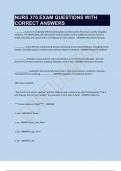NURS 370 EXAM QUESTIONS WITH
CORRECT ANSWERS
_________ based on completely different philosophies and life systems than those used by allopathic
medicine. The NIH/NCCAM calls them whole medical systems such as traditional Chinese medicine
(TCM), Ayurveda, and various forms of traditional or folk medicine. - ANSWER-Alternative therapies
._________ is less effective in preventing disease, decreasing stress-induced illnesses, managing chronic
disease, and addressing the emotional and spiritual needs of individual - ANSWER-Allopathic medicine
.__________ therapies may include the same interventions as complementary therapies, but they
become the primary treatment, replacing allopathic medical care - ANSWER-Alternative therapies
.____________ medication has successfully been used to treat many common conditions. However,
many patients are exploring __________ - ANSWER-Allopathic or Traditional Western
Alternative methods
."My throat hurts when I swallow." and Our children have no place to go after football games. That is
why they get into so much trouble." are examples of what type of data? - ANSWER-subjective
.***review resiliency trifold**** - ANSWER-
.1 inch - ANSWER-2.54 cm
.1 oz - ANSWER-6tsp, 2 tbs, 30ml
.1 tbs - ANSWER-3 tsp, 15 ml
.1 tsp - ANSWER-5 mL
,.1) identify significant data - ANSWER-Significant data (also called cues):
■ Influence your conclusions about the client's health status.
■ Usually are unhealthy responses.
■ Draw on your theoretical knowledge (e.g., of anatomy, physiology, psychology).
■ One cue should alert you to look for others that might be related to it (forming a pattern).
Example: Suppose you have noted that a woman's pulse rate is 110 beats/min. Is this an unhealthy
response—a cue? Compare the rate with your theoretical knowledge—for example, the normal range
for an adult pulse is 60 to 100 beats/min. This woman is a longtime cigarette smoker who also drinks a
lot of coffee. These habits increase pulse rate, so 100 beats/min may be a normal finding for this client.
.1g= - ANSWER-1000mg
.1kg - ANSWER-1000g
.1L - ANSWER-1000mL
.1mcg - ANSWER-0.001mg
.1mg - ANSWER-1000mcg
.1mm - ANSWER-0.001m
.2.2 lb - ANSWER-1 kg
.2) cluster cues - ANSWER-cluster is a group of cues that are related to each other in some way. The
cluster may suggest a health problem. Key Point: To help ensure accuracy, you should always derive a
nursing diagnosis from data clusters rather than from a single cue.
Example: Alma was transferred to the hospital from a long-term care facility. Because of a CVA
(cerebrovascular accident, or stroke), Alma can make sounds but cannot speak; and because of joint
contractures, she cannot use her hands and arms. Alma is frequently incontinent of urine, so the nurses
have diagnosed Total Urinary Incontinence and are resigned to the idea that Alma will not be able to
,control her urine. When a nursing student is assigned to the care for Alma, the student looks for
additional cues
.3 domains of learning (client education) - ANSWER-cognitive (knowledge, comprehension, application
etc..)
psychomotor (acquisition of new skills)
affective (expression of feelings)
.3) identify inconsistencies and gaps - ANSWER-Data Gaps As another example, look again at Todd's data
(Meet Your Patient). Except for medical diagnoses, there are very few data. The following data gaps
exist:
■ His admitting diagnosis, chronic renal failure, suggests the possibility of fluid imbalance; however, data
needed to support that are decreased intake and output, dark urine, skin turgor, and complaints of
thirst.
■ Admission to the ED could cause Anxiety. To pursue that line of thinking, observe for physical and
verbal symptoms of Anxiety.
■ Decreased sensation in his lower extremities could create mobility or safety problems. You would
need to know the degree of sensation loss and the exact meaning of "slight loss of mobility" to confirm a
diagnosis.
Inconsistencies In addition to missing data, look for inconsistencies in the data. Suppose a client tells
you, "I really don't eat much. However, she is 5 ft tall and weighs 190 lb. This seems inconsistent
because your theoretical knowledge tells you that obesity is usually caused by excessive intake of
calories. You would need more specific data about what this client actually eats or whether she has any
medical problems that might cause obesity (e.g., hypothyroidism); or whether she lacks knowledge
about the calorie content various foods?
.5 stages of nursing competence - ANSWER-novice
advanced beginner
competent
proficient
expert
.5 steps of the nursing process - ANSWER-Assessment (gather info about client's condition)
Diagnosis (identify client's problems)
, Planning (set goals of care and desired outcomes and identify appropriate nursing actions)
Implementation (perform the nursing actions identified in planning)
Evaluation (determine if goals met and outcomes achieved)
.a nursing diagnosis should not be related to a medical diagnosis. However, - ANSWER-the use of a
medical diagnosis may add clarity to the diagnosis
the nurse can link the statement with the phrase "secondary to"
.ABC's - ANSWER-airway, breathing, circulation
.Actual Nursing Diagnosis: Problem Is Present - ANSWER-A problem response that exists at the time of
the assessment.
Signs and symptoms (cues) that are present.
Todd may have at least one actual nursing diagnosis (Impaired Walking or perhaps Impaired Physical
Mobility), related to his lack of peripheral sensation; however, no signs and symptoms were given in the
scenario to support that diagnosis.
.Acute vs. Chronic - ANSWER-Acute needs may pose more of a threat
Chronic needs usually develop over period of time
Attend to alteration in acute phase before they evolve into chronic alteration
.Adaptability - ANSWER-Adaptability is the confidence and understanding to create and pursue a skillful
outcome that best meets the challenge.
•Self-defeating thoughts produce negative outcomes and impact relationships & the ability to enjoy life
•Can I alter my challenge so it is more positive?




